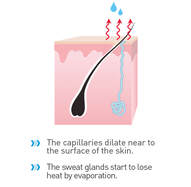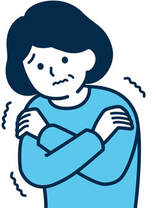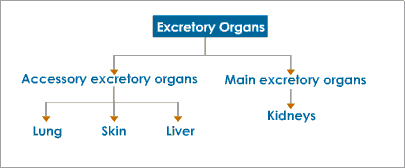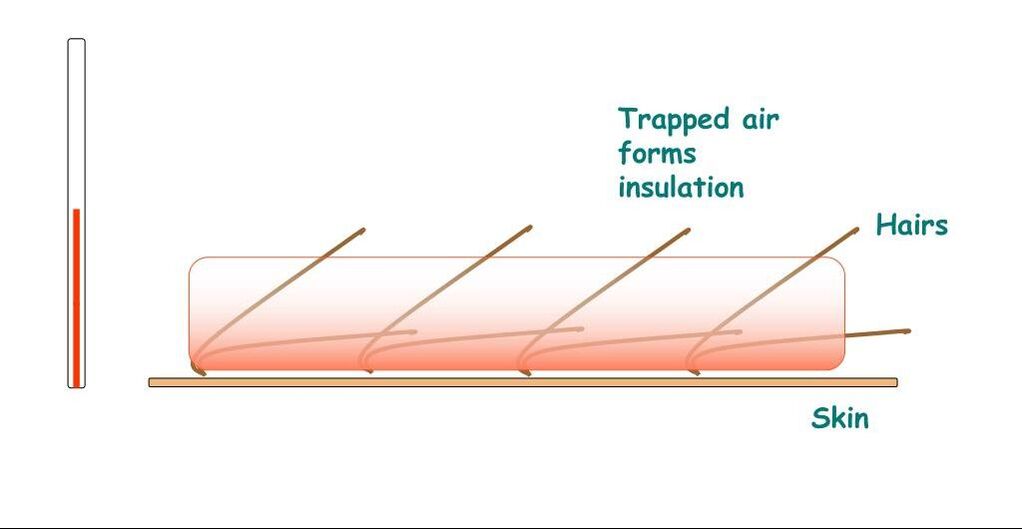topic 3: Homeostasis and Thermoregulation

State that homeostasis is the maintenance of a constant internal environment and that body temperature is an example of homeostasis
State: Give a specific name, value or other brief answer without explanation or calculation.
State: Give a specific name, value or other brief answer without explanation or calculation.

The human organism consists of cells working together to maintain the organism. While cells may perform different functions, all the cells are quite similar in their metabolic activity. Maintaining a constant internal environment with all that the cells need to survive is necessary for the well-being of individual cells and the well-being of the entire body. Homeostasis is the control of internal conditions, be it temperature, specific blood conditions or other variables within living organisms.
The purpose of homeostasis is to provide a consistent internal environment for proper enzymatic activities. Each process, or reaction, has a desirable peak environment. Influences, such as an external influence, can cause deviation away from this norm level and the body will correct this change – this is called negative feedback.
Negative feedback is the most common type of reaction, because it is only natural to rectify a potential problem, but there is also positive feedback. This is when the body will push itself further away from the normal level.
The purpose of homeostasis is to provide a consistent internal environment for proper enzymatic activities. Each process, or reaction, has a desirable peak environment. Influences, such as an external influence, can cause deviation away from this norm level and the body will correct this change – this is called negative feedback.
Negative feedback is the most common type of reaction, because it is only natural to rectify a potential problem, but there is also positive feedback. This is when the body will push itself further away from the normal level.
Explain how organisms are able to respond to changes in their environment
Explain: Give a detailed account.
Explain: Give a detailed account.

Changes occur in the external environment of all organisms on Earth. Species have changed over thousands of years in a changing environment. Multicellular organisms rely on body systems to function together so all the cells have the right conditions such as, levels of nutrients and oxygen, and also so their toxic wastes are removed. The circulatory, respiratory, digestive, excretory system in humans work together to provide a relatively stable internal environment in cells.
State that the lungs, kidneys and skin are organs of excretion
State: Give a specific name, value or other brief answer without explanation or calculation.
State: Give a specific name, value or other brief answer without explanation or calculation.
The excretory system is a passive biological system that removes excess, unnecessary or dangerous materials from an organism. This process helps maintain the homeostasis within the organism and prevent damage to the cells. It is responsible for the elimination of the waste products of metabolism as well as other liquid and gaseous wastes. As most healthy functioning organs produce metabolic and other wastes, the entire organism depends on the function of the system; however, only the organs specifically for the excretion process are considered a part of the excretory system.
Evaluate the relationship between surface area, volume and surface area to volume ratio in relationship to heat loss
Evaluate: Make an appraisal by weighing up the strengths and limitations.
Evaluate: Make an appraisal by weighing up the strengths and limitations.
 image from www.open.edu
image from www.open.edu
Small-bodied animals or plant parts (e.g., leaves) heat up and cool down faster; bigger and/or thicker bodies heat up and cool down slower. Smaller/thinner bodies have a larger surface area to volume ratio. Bodies gain and lose heat out of the surface of their body; more surface area means greater gains and losses. Bodies retain heat within their bodies; more volume means more heat retention. When the surface area is large compared to the volume (small/thin things), heat is gained and lost quickly because there is lots of surface area to gain and lose heat and relatively little volume to retain heat.
Advantages and Disadvantages to being Large:
Advantages and Disadvantages to being Large:
- Heat is gained and lost more slowly so, for example, on a hot summer day, the a large animal may never reach lethal temperatures by the time the sun sets.
- Because heat is lost more slowly, the animal doesn't have to replace lost heat as quickly; therefore, the animal doesn't have to eat as much compared to its body weight (e.g., only has to eat 1/4 its body weight). However, it usually does have to eat more total food than a smaller animal.
- Heat is gained and lost faster so, for example, on a hot summer day, a small leaf (less than about 1 square centimeter) will shed heat as fast as it acquires heat; therefore the leaf will never reach temperatures higher than air temperature (compared to a large, thick leaf that acquires a heat load and can reach very high, lethal temperatures).
- Because heat is lost faster, the animal has to eat faster to replace the lost energy (e.g., very small mammals may eat up to 4 times their body weight each day).
Explain the concept of control by negative feedback in homeostasis
Explain: Give a detailed account
Explain: Give a detailed account
 image from www.blendspace.com
image from www.blendspace.com
Almost all homeostatic control mechanisms are negative feedback mechanisms. These mechanisms change the variable back to its original state or “ideal value”. Negative feedback in homeostasis describes a process by which bodily systems maintain their normal environments or states. Homeostasis describes the body's overall regulation of its internal systems. When changes in a state such as body temperature occur, negative feedback responses are triggered to bring the temperature back to its normal point. For example, if the body becomes too hot, sweating occurs to cool it. If the body becomes too cold, shivering is one response that helps to warm it up
Describe thermoregulation humans in terms of insulation and the role of temperature receptors in the skin,
Describe: Give a detailed account or picture of a situation, event, pattern or process.
Describe: Give a detailed account or picture of a situation, event, pattern or process.

Thermoregulation is the process by which the body maintains its core temperature within a narrow range, despite changes in the environment. In humans, this process involves both behavioral and physiological mechanisms.
Sweating, vasodilation and vasoconstriction, piloerection, and shivering act together to keep the body temperature within 37 C.
One key aspect of thermoregulation is insulation. The body is able to conserve heat by reducing the amount of heat that is lost to the environment through the skin. This is accomplished through a variety of mechanisms, including the use of clothing and the regulation of blood flow to the skin.
Temperature receptors in the skin also play a critical role in thermoregulation. These receptors detect changes in the external temperature and send signals to the hypothalamus, a region of the brain that acts as the body's thermostat. When the external temperature drops, the hypothalamus signals the body to conserve heat through behaviors like shivering and constriction of blood vessels. When the external temperature rises, the hypothalamus signals the body to dissipate heat through behaviors like sweating and dilation of blood vessels.
Sweating, vasodilation and vasoconstriction, piloerection, and shivering act together to keep the body temperature within 37 C.
One key aspect of thermoregulation is insulation. The body is able to conserve heat by reducing the amount of heat that is lost to the environment through the skin. This is accomplished through a variety of mechanisms, including the use of clothing and the regulation of blood flow to the skin.
Temperature receptors in the skin also play a critical role in thermoregulation. These receptors detect changes in the external temperature and send signals to the hypothalamus, a region of the brain that acts as the body's thermostat. When the external temperature drops, the hypothalamus signals the body to conserve heat through behaviors like shivering and constriction of blood vessels. When the external temperature rises, the hypothalamus signals the body to dissipate heat through behaviors like sweating and dilation of blood vessels.
Explain the process of sweating and how it helps regulate body temperature in humans.
Explain: Give a detailed account
Explain: Give a detailed account

Sweating is the process by which the body produces and releases sweat, a fluid consisting primarily of water, salts, and various other substances. Sweat is produced by sweat glands located throughout the skin, and is released through pores onto the surface of the skin.
The primary function of sweating is to regulate body temperature. When the body becomes too warm, such as during exercise or exposure to high temperatures, the hypothalamus, a region of the brain that acts as the body's thermostat, signals the sweat glands to produce and release sweat. As the sweat evaporates from the skin, it helps to dissipate heat and cool the body.
In addition to its cooling function, sweating also serves other important roles in the body. Sweat helps to maintain hydration by replacing fluids lost through other means, such as respiration and urine production. Sweat also contains antimicrobial peptides that can help protect the skin against infections.
The amount of sweat produced by the body is influenced by a variety of factors, including temperature, humidity, exercise, and emotional state. In some cases, excessive sweating can be a sign of an underlying medical condition, such as hyperthyroidism or an infection.
The primary function of sweating is to regulate body temperature. When the body becomes too warm, such as during exercise or exposure to high temperatures, the hypothalamus, a region of the brain that acts as the body's thermostat, signals the sweat glands to produce and release sweat. As the sweat evaporates from the skin, it helps to dissipate heat and cool the body.
In addition to its cooling function, sweating also serves other important roles in the body. Sweat helps to maintain hydration by replacing fluids lost through other means, such as respiration and urine production. Sweat also contains antimicrobial peptides that can help protect the skin against infections.
The amount of sweat produced by the body is influenced by a variety of factors, including temperature, humidity, exercise, and emotional state. In some cases, excessive sweating can be a sign of an underlying medical condition, such as hyperthyroidism or an infection.
Describe the factors that influence sweat production, including temperature, humidity, and exercise.
Describe: Give a detailed account or picture of a situation, event, pattern or process.
Describe: Give a detailed account or picture of a situation, event, pattern or process.
Sweat production is influenced by a variety of factors, including:
- Temperature: As the body temperature rises, the hypothalamus signals the sweat glands to produce more sweat in order to help cool the body.
- Humidity: High humidity can inhibit evaporation of sweat from the skin, reducing its cooling effect and potentially increasing sweat production.
- Exercise: Physical activity can increase body temperature and metabolic activity, leading to increased sweat production. In addition, exercise can stimulate the sympathetic nervous system, which can also increase sweat production.
- Clothing: Clothing can impact sweat production by affecting heat transfer and evaporative cooling. Tight-fitting or synthetic fabrics may inhibit sweat evaporation and increase discomfort, while loose-fitting and breathable fabrics can enhance evaporative cooling.
- Age: Young children and elderly adults may have a reduced capacity to produce sweat, making them more susceptible to heat-related illnesses.
- Gender: Women may have a lower sweat rate than men, although this can vary depending on factors such as body size and fitness level.
- Medications and medical conditions: Certain medications, such as anticholinergics, can inhibit sweat production, while medical conditions such as hyperthyroidism or diabetes can affect sweat production and regulation.
Explain how they help regulate body temperature in humans.
Explain: Give a detailed account
Explain: Give a detailed account

Blood flows through small capillaries within the dermis layer of the skin. Heat radiates to the outside of the skin helping to cool the body down. If the body is too hot small arteries (arterioles) leading to the capillary loops dilate (widen). In cold conditions the opposite happens. the arterioles leading the the surface capillary loops constrict ( become narrower) and blood flow to the skin id reduced, so that less heat is lost.
Vasodilation and vasoconstriction are processes that help to regulate body temperature in humans.
Both vasodilation and vasoconstriction are important for maintaining homeostasis in the body, which is the balance of internal conditions necessary for survival. If the body becomes too hot or too cold, it can lead to damage of the cells and tissues. By regulating blood flow to the skin, the body is able to maintain a relatively constant body temperature, which allows the cells and tissues to function properly.
Vasodilation and vasoconstriction are processes that help to regulate body temperature in humans.
- Vasodilation is the widening of blood vessels in response to increased body temperature. This allows for increased blood flow to the skin, which allows for more heat to be released into the environment through radiation and convection, helping to cool the body. The process is controlled by the autonomic nervous system, specifically the release of chemicals like nitric oxide that cause the smooth muscle cells in blood vessel walls to relax.
- Vasoconstriction is the narrowing of blood vessels in response to cold temperatures. This reduces blood flow to the skin, which helps to conserve heat and maintain body temperature. The process is also controlled by the autonomic nervous system, specifically through the release of chemicals like norepinephrine that cause the smooth muscle cells in blood vessel walls to contract.
Both vasodilation and vasoconstriction are important for maintaining homeostasis in the body, which is the balance of internal conditions necessary for survival. If the body becomes too hot or too cold, it can lead to damage of the cells and tissues. By regulating blood flow to the skin, the body is able to maintain a relatively constant body temperature, which allows the cells and tissues to function properly.
Describe the role of piloerection in thermoregulation in humans.
Describe: Give a detailed account or picture of a situation, event, pattern or process.
Describe: Give a detailed account or picture of a situation, event, pattern or process.

Piloerection, also known as "goosebumps" or "hair standing on end", is a physiological response in which the hair follicles on the skin contract, causing the hair to stand up.
Piloerection plays a role in thermoregulation in humans by helping to trap a layer of air between the hair and the skin, which can help to insulate the body against cold temperatures. When the body is exposed to cold temperatures, the hypothalamus signals the smooth muscle cells in the skin to contract, causing the hair follicles to stand up and creating a layer of insulation that can help to conserve heat. This is similar to how insulation in a house can help to keep warm air inside and cold air outside.
Piloerection plays a role in thermoregulation in humans by helping to trap a layer of air between the hair and the skin, which can help to insulate the body against cold temperatures. When the body is exposed to cold temperatures, the hypothalamus signals the smooth muscle cells in the skin to contract, causing the hair follicles to stand up and creating a layer of insulation that can help to conserve heat. This is similar to how insulation in a house can help to keep warm air inside and cold air outside.
Explain how it helps regulate body temperature in humans.
Explain: Give a detailed account
Explain: Give a detailed account

Shivering is an involuntary muscular response in which the muscles contract rapidly and repeatedly, causing the body to shake. Shivering helps to generate heat and maintain body temperature in cold environments.
When the body is exposed to cold temperatures, the hypothalamus signals the skeletal muscles to contract rapidly, which generates heat through muscular activity. The increased metabolic activity associated with shivering can help to raise body temperature and maintain core temperature within a narrow range.
Shivering is controlled by the autonomic nervous system, specifically the sympathetic nervous system, which is responsible for regulating involuntary bodily functions
When the body is exposed to cold temperatures, the hypothalamus signals the skeletal muscles to contract rapidly, which generates heat through muscular activity. The increased metabolic activity associated with shivering can help to raise body temperature and maintain core temperature within a narrow range.
Shivering is controlled by the autonomic nervous system, specifically the sympathetic nervous system, which is responsible for regulating involuntary bodily functions
Key Terms:
|
homeostasis
shivering adrenaline latent heat |
vasoconstriction
vasodilation sweat pileoerection |
epidermis
hypodermis dermis vaporisation |
dilate
constrict arterioles hypothalamus |
homeothermic
endotherms negative feedback denature thermoregulatory centre thermostat |
Class Materials:
Part 1 Homeostasis and Temperature Control
Homeostasis.
Homeostasis Study Guide
Homeostasis Poster.
Useful Links:
Read the 3 articles on Homeostasis
Check out this animation of vasoconstriction
Check out this useful website on Homeostasis
Click here for a great animation on Positive and Negative Feedback
Biology 4 Kids
McGraw Hill Positive and Negative Feedback animation
Homeostasis Study Guide
Homeostasis Poster.
Useful Links:
Read the 3 articles on Homeostasis
Check out this animation of vasoconstriction
Check out this useful website on Homeostasis
Click here for a great animation on Positive and Negative Feedback
Biology 4 Kids
McGraw Hill Positive and Negative Feedback animation
Video Clips:
Hank takes us on the fascinating journey through our excretory system to learn how our kidneys make pee.
Paul Andersen explains how feedback loops allow living organisms to maintain homeostasis. He uses thermoregulation in mammals to explain how a negative feedback loop functions. He uses fruit ripening to explain how a positive feedback loop functions. He also explains what can happen when a feedback look is altered. Diabetes mellitus is caused by an alteration in the blood glucose feedback loop







